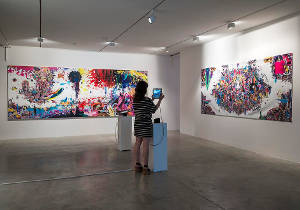CURATOR'S CHOICE SM
Exhibition Reviews
| Home | | Museum
Guide | | International |
| Theater |
| "Duality
of Existence – Post Fukushima"
"Duality of Existence – Post Fukushima"
The Japanese identity has long been questioned and dissected through Japanese art; its discourse is abundant in conceptual, aesthetic and literary meaning.
The works presented at the Friedman Benda gallery attest to the creative muscle of the Japanese contemporary art scene, particularly in terms of the integration of technology with traditional media now that we are in the digital epoch. The exhibition is in the spirit of the times, up-to-date. Digital technology is applied through different media: video, applications for the iPad which convey the essence of the work and a broadcast by Skype with a Japanese artist on a Mac. The Japanese touch is clearly shown, from Kazuki Umezawa's works with his manga iconography and color to the fastidiousness of "Reflection Model" in wood by the artist Takahiro Iwasaki. These attest to the talent and savoir-faire of the Japanese Artist, who has replaced the samurai as a charismatic value of Japanese society for a long time. Indeed, if the Japanese identity is questioned through its art, it's because Japanese artists hold a social rank that is quite singular.
The works exhibit the state of an art which is always marked by poetry and elegance. Their voluptuousness is typical of the Japanese aesthetic. "The duality of existence" in the title of this exhibition refers to the physical and psychological dichotomies in the contemporary Japanese society due to the digital epoch. However, in Japan, the "duality of existence" is nothing new and Japanese contemporary arts have fed off this "dualism" for a long time. Torn between tradition and modernity, Japan has constantly been in an attempt to redefine its identity. Obviously, Fukshima, like a social disaster, both in its causes and consequences, has upset the Japanese consciousness.
"Duality of Existence – Post Fukushima" as a theme and a title is relevant, eye-catching and daring. In theory, this exhibition should be convincing. However, the reality is disappointing. Friedman Benda gallery presents an exhibition without a guiding principle, led by vague explanations and a dubious relationship with the Japanese post-Fukushima identity. Unfortunately, the theme announced put the works at a disadvantage. The expectation is big, on a par with the extent and tragedy of this disaster. Putting a label "Post Fukushima" on an exhibition is both a risk and flamboyance. Some works, too explicit to be powerful, stand alongside other which are unrelated to the disaster. The exhibition seems to confront the real and the virtual much more than address "The most current reactions to the new reality in Japan," due to "The imminent threat of atomic catastrophe in March 2011," as the Freidman Benda gallery press release says. The coherence, in the juxtaposition of its works, would be that these works sublimate the painful complexity of Modernity, giving life to a virtual identity. Virtuality, according to the British sociologist Zygmunt Bauman, symbolic of a "liquid modernity," is characterized by ephemeralness, uncertainty and conflict in the quest for identity. This explanation would justify the broadcasting of a Skype with Elie, the only female member of the controversial collective Chim?Pom, who has been prohibited from entering the United States ever since a travel companion filled out her visa questionnaire with false answers. This installation would have had the same resonance without mentioning the Fukushima disaster. In any case, there isn't a "re-evaluation of human existence in Japan." "Duality of Existence – Post Fukushima" is a risky
title, but sometimes a risk doesn't pay off. |


